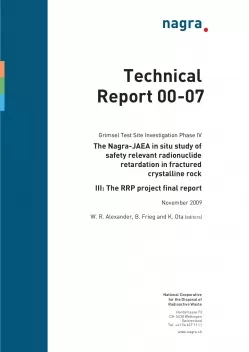
Technical Report NTB 00-07
Grimsel Test SiteInvestigation Phase IV:The Nagra-JAEA in situ study of safety relevant radionuclide retardation in fractured crystalline rock III: The RRP project final report
To enhance the understanding of radionuclide transport/retardation in fractured rock, Nagra and JAEA worked together for nearly 15 years on a Radionuclide Migration Programme (RMP) at Nagra’s Grimsel Test Site (GTS). This started with the MI (Migration Experiment) project and moved on to EP (Excavation Project) and the CP (Connected Porosity) project. Traditionally, studies such as MI produce data for the overall flow system "seen" by the radionuclides. These data are then modelled to produce a set of "best fit" bulk or average values for the transport/ retardation parameters. However, the model values obtained may not be an unique solution and, from this process, no detailed information is obtained about where the retardation actually takes place. The extrapolation from one site, or flow system, to another where properties are different can only be done, if the underlying processes are well understood.
This is a key issue as, in practice, the geosphere around a radioactive waste repository will not be exhaustively explored, due to the necessity to maintain favourable characteristics in as unperturbed a state as possible. Hence, it is essential that extrapolations from nearby or similar sites, where such restrictions do not apply, can be justified by a thorough understanding of the factors influencing in situ radionuclide transport and retardation. As part of this strategy, Nagra and JAEA proposed another experiment which took a step further than MI – EP.
The Nagra-JAEA Excavation Project (EP) was a very challenging project where, for the first time, radionuclide cocktails of strongly sorbing radionuclides with complex chemistries were injected into a water-conducting shear zone, followed by the excavation of the traced part of the shear zone (approximately two tonnes of rock). The development, improvement and testing of new methodologies and techniques was required owing to the complexity of the project and to the scale of the in situ experiment. The extensive efforts that were undertaken in order to guarantee a successful experiment also required a series of laboratory and field tests at the GTS, the latter wherever possible under conditions closely resembling the final experiment.
The Excavation Project (EP) began in 1990 with the Phase I feasibility study and continued in Phase II with an extensive campaign of laboratory and field tests between 1994 and 1996. This final report provides a summary of the Phase III work, which included:
- Injection of four different radionuclide cocktails into the EP test zone that was established in the AU96 experimental shear zone (MI shear zone) at the GTS.
- Continuous monitoring of radiotracer breakthrough at the outlet borehole followed by stabilisation of the rock volume containing the retarded radionuclides by in situ resin impregnation.
- Excavation of the stabilised rock volume by shear zone-parallel overcoring for sample recovery and laboratory investigations.
- Radiochemical analysis on solid shear zone samples and detailed structural geological investigation of the flow-path geometry within the dipole.
One of the aims of EP was to examine the behaviour of PA (performance assessment) relevant radionuclides and so those nuclides selected for consideration in Nagra’s Kristallin-1 PA and JAEA’s TRU-I PA were examined. The final selection was
238U, 235U and 234U:safety relevant
237Np:safety relevant
99Tc:safety relevant
152Eu:considered to be a good chemical analogue for other lanthanides and trivalent actinides
60Co:good chemical analogue for safety relevant 59Ni and easier to obtain and simpler to analyse than 59Ni
75Se:complete chemical analogue of safety relevant 79Se, but much shorter half-life (120 days against 65 ka)
113Sn:complete chemical analogue of safety relevant 126Sn, but much shorter half-life (115 days against 100 ka)
stable Mo:complete chemical analogue of safety relevant 93Mo (half-life of 3.5 ka)
Scoping calculations indicated that the low natural solubilities of these radionuclides in the Grimsel groundwater/rock system meant that the likely activities retained in the shear zone would be significantly below the detection limits of any surface analytical and radiochemical methods available at the time. Consequently, it was decided to alter the focus of the experiment by injecting much higher levels of radionuclides into the system than would be feasible under normal solubility controls (by injecting the radionuclides in acidified solutions). Obviously, this meant that the geochemistry of the system would no longer be realistic, but the information which would be provided on transport pathways (from the labelling of the flow-paths by the radionuclides) would still be of great value for testing conceptual models of transport in complex flow systems.
Consideration was given to determine the flowpath geometry by simply injecting resin into the flow-field, but this was rejected for two reasons:
- There were indications that the resin might not impregnate minor flow-paths, owing to viscosity and polymerisation limitations.
- It was felt that carrying out such an experiment with safety relevant radionuclides would build the necessary experience required to conduct similar future studies in the Swiss and Japanese programmes on repository-relevant systems. Further, experience in handling high activities and α-emitters would increase confidence in what can be achieved in URLs overall.
As such, the behaviour of the radionuclides in the flow system cannot be directly used in PA calculations, but they proved invaluable in mapping out actual flow-paths in this highly complex flow system. Analysis of the so labelled flow-paths clearly showed the impact of double porosity transport and the complexities of flow and retardation in three dimensions (3D) where fracture "branches" and fracture fill "islands" all play a role. The significance of retardation in the fracture fill compared to the matrix for strongly retarded radionuclides should not be overlooked. This is probably a good reflection of what will happen in a fractured repository host rock, with strongly sorbing radionuclides having little chance to access the matrix when so many sites of retardation exist in the fracture filling material.
